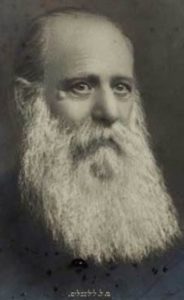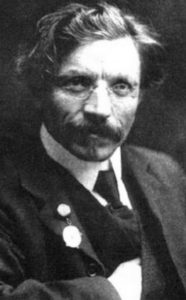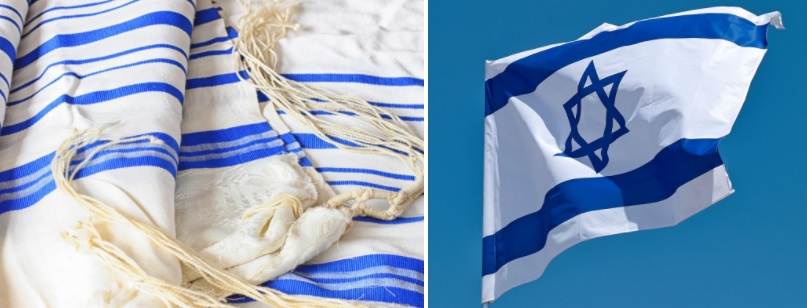Hovevei Zion, The “Lovers of Zion”
Shmuel Mohilever (1824-1898) was born in what is today Belarus to a deeply religious family. He studied at the famed Volozhin Yeshiva and became a rabbi. Violent pogroms against Jews in Russia in 1881, followed by the antisemitic May Laws of 1882, convinced Rabbi Mohilever that Jews would never be safe in the diaspora and must return to their ancestral home. In 1882, he took a trip to Paris to meet with Edmond James de Rothschild and convinced him to fund Jewish settlements in the Holy Land. While chief rabbi of the town of Bialystok, Rabbi Mohilever would inspire Jews in his community to make aliyah. In 1884, he joined a group of leaders in Katowice (then in Prussia, today in Poland) to formally establish Hovevei Zion, the “Lovers of Zion”, into an organized movement. At the meeting, he was elected president while Leon Yehuda Leib Pinsker (1821-1891) was elected secretary. Pinsker was born to a secular Russian-Jewish family in what is today Poland. He was one of the first Jews to attend Odessa University to study law. However, restrictions on Jews becoming lawyers made him switch to medicine and Pinsker became a physician. At first, Pinsker believed Jews must assimilate into European society and that this would end antisemitism. He soon saw that this was not working at all, and concluded that antisemitism is a misnomer; the proper term should be “Judeophobia”, since fear and hatred of Jews is irrational, deep-seated, and essentially incurable. He started writing articles to convince Jews to move to their homeland, since everywhere else they would inevitably be hated. He worked closely with Moshe Leib Lilienblum (1843-1910) who, like Rabbi Mohilever, was born to a deeply religious Russian-Jewish family. Lilienblum was a noted Jewish scholar from a young age, and soon founded and headed a yeshiva in Vilnius. With time, however, he saw that poverty and persecution in exile was destroying his people. He became a committed Zionist, recognizing that the only solution for the Jewish people is to return to Israel and establish their own independent state. Lilienblum wrote a great deal of early Zionist literature. When Rabbi Mohilever distanced himself from Hovevei Zion because it was becoming too secular, Lilienblum took over as president. Hovevei Zion went on to convince countless Jews around the world to take up the Zionist call, and founded the cities of Rishon LeZion, Hadera, and Rehovot in Israel. Rabbi Mohilever, meanwhile, set the stage for the Mizrachi religious Zionist movement. He made sure that Jewish settlement in Israel conformed to Jewish law. The town and kibbutz of Gan Shmuel in Israel was founded in his honour in 1895.
Video: The Hidden History of Zionism
Words of the Week
To the living, the Jew is a corpse; to the native, a foreigner; to the homesteader, a vagrant; to the proprietary, a beggar; to the poor, an exploiter and a millionaire; to the patriot, a man without a country; for all, a hated rival.
– Leon Pinsker




 David Wolffsohn (1856-1914) was born to a poor, religious Jewish family in the Lithuanian-Polish town of Darbenai (then part of Russia). His father was a Torah scholar and teacher, and Wolffsohn, too, was learning in yeshiva with the same goal in mind. In his teens, he was sent to live with relatives in Germany to avoid being conscripted to the Russian army. There, he met the rabbi, philosopher, and early Zionist leader Isaac Rülf, and became his devoted disciple. Meanwhile, Wolffsohn took up secular studies and went on to apprentice at a trading company. In 1877, he started his own flouring business, and was soon one of the most prominent Jewish businessmen in Europe. Henceforth, he dedicated his life to realizing that ancient dream of his people’s return to Israel. He played a key role within the Hovevei Zion movement, and in 1894 was a cofounder of the Society for the Promotion and Support of Jewish Agriculture in Syria and Palestine. When Herzl’s The Jewish State was published two years later, Wolffsohn immediately journeyed to Vienna to meet him. The two became very close and traveled the Holy Land together, setting the foundations for what would become the State of Israel. Not surprisingly, when the World Zionist Congress was founded, Herzl was made its president and Wolffsohn its vice-president. Upon Herzl’s death shortly after, Wolffsohn succeeded him. As president, he was instrumental in reinvigorating Jewish life in the Holy Land (among other things, it was under his tenure that the city of Tel-Aviv was founded). However, Wolffsohn is most famous for being the one who created the flag of modern Israel. Back in 1896, Herzl had written: “We have no flag, and we need one. If we desire to lead many men, we must raise a symbol above their heads. I would suggest a white flag, with seven golden stars…” Herzl’s proposal was good, but his flag gained little support. Wolffsohn responded to Herzl thus: “We have a flag—and it is blue and white. The talit with which we wrap ourselves when we pray: that is our symbol. Let us take this talit from its bag and unroll it before the eyes of Israel and the eyes of all nations…” Wolffsohn designed a simple flag with blue talit-like stripes and a
David Wolffsohn (1856-1914) was born to a poor, religious Jewish family in the Lithuanian-Polish town of Darbenai (then part of Russia). His father was a Torah scholar and teacher, and Wolffsohn, too, was learning in yeshiva with the same goal in mind. In his teens, he was sent to live with relatives in Germany to avoid being conscripted to the Russian army. There, he met the rabbi, philosopher, and early Zionist leader Isaac Rülf, and became his devoted disciple. Meanwhile, Wolffsohn took up secular studies and went on to apprentice at a trading company. In 1877, he started his own flouring business, and was soon one of the most prominent Jewish businessmen in Europe. Henceforth, he dedicated his life to realizing that ancient dream of his people’s return to Israel. He played a key role within the Hovevei Zion movement, and in 1894 was a cofounder of the Society for the Promotion and Support of Jewish Agriculture in Syria and Palestine. When Herzl’s The Jewish State was published two years later, Wolffsohn immediately journeyed to Vienna to meet him. The two became very close and traveled the Holy Land together, setting the foundations for what would become the State of Israel. Not surprisingly, when the World Zionist Congress was founded, Herzl was made its president and Wolffsohn its vice-president. Upon Herzl’s death shortly after, Wolffsohn succeeded him. As president, he was instrumental in reinvigorating Jewish life in the Holy Land (among other things, it was under his tenure that the city of Tel-Aviv was founded). However, Wolffsohn is most famous for being the one who created the flag of modern Israel. Back in 1896, Herzl had written: “We have no flag, and we need one. If we desire to lead many men, we must raise a symbol above their heads. I would suggest a white flag, with seven golden stars…” Herzl’s proposal was good, but his flag gained little support. Wolffsohn responded to Herzl thus: “We have a flag—and it is blue and white. The talit with which we wrap ourselves when we pray: that is our symbol. Let us take this talit from its bag and unroll it before the eyes of Israel and the eyes of all nations…” Wolffsohn designed a simple flag with blue talit-like stripes and a 